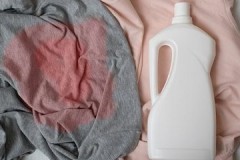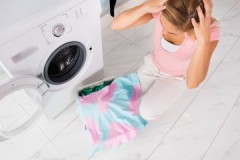Respect and careful care, or how to wash a goat down shawl at home
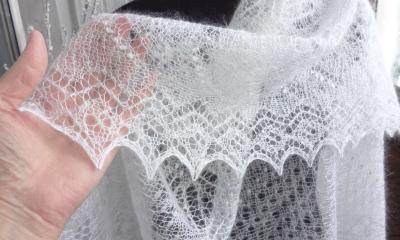 A warm winter shawl, knitted from goat down, requires careful handling and no less careful care.
A warm winter shawl, knitted from goat down, requires careful handling and no less careful care.
The correct choice of detergents and adherence to the technology of washing, bleaching, fluffing allows you to maintain the shape and heat-saving qualities of an openwork thing.
There are several technologies for cleaning and drying knitted garments. How to properly wash and dry a downy shawl at home, read the article.
Content
How to choose the right detergent?
Not all products containing a soap component are suitable for washing downy shawl. Conventional washing powder is not used in this case, as it negatively affects the quality of the down. This is especially true of the white thread shawl.
The knitted fabric can lose volume or turn yellow under the influence of the microgranules of the powder. Harsh stain removers and bleaches used for everyday wear are also taboo.
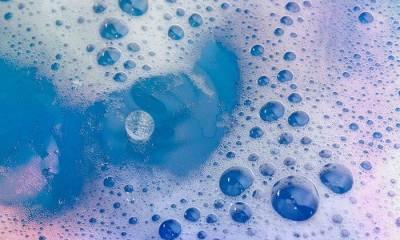 The most suitable laundry detergents are:
The most suitable laundry detergents are:
- hair shampoo (preferably for dry hair);
- liquid soap without dyes and fragrances;
- soap solution from hypoallergenic baby soap;
- liquid detergent for delicate wash;
- gel for washing woolen or downy items.
When choosing a foaming liquid, consider the washing method.
If you plan to wash the shawl in a machine with an automatic mode, then the product must be suitable for this application. Hand wash allows you to use any of the options.
When is dry cleaning and when is a full wash?
With frequent wear, the down cover and the woolen thread itself can become covered with dust and dirt. The shawl actively absorbs all kinds of odors, therefore it is recommended to protect it from cigarette smoke, strong perfume.
Clean the handkerchief from light dirt with a soft sponge. She is gently carried along the canvas, without strong pressure.
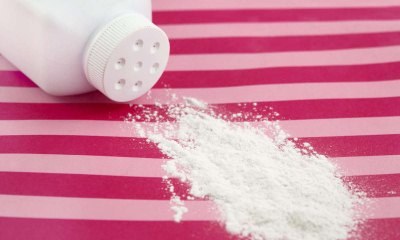 Suitable for deeper dry cleaning:
Suitable for deeper dry cleaning:
- bran (rye, wheat);
- cereals;
- potato flour;
- talc.
The natural product powder is heated in a water bath to a hot state. Then rub the scarf with bran or powder.
The remaining cleaning agent is shaken out or removed with a vacuum cleaner. It is advisable to repeat the cleaning of the most dirty places twice.
If the "cobweb" is very dirty, and the fluff has fallen off, then dry cleaning may not cope with the task... Soap solution will help solve the problem. They also resort to washing if local dirt appears on the clothes.
It is recommended to wash the shawl only when urgently needed, as too frequent washing deteriorates its quality.
Preparation for the process
Before proceeding with wet cleaning, the product must be prepared. First, the shawl is shaken to remove all particles that have not had time to fix in the down layer.
Then the thing is combed with a wooden comb with rare blunt teeth... This procedure preserves the fluffy cover of the shawl. Further, using a dry sponge, dust and fine dry dirt are removed from the canvas.
If there are stains on the spider web, then they are discolored before general washing. The method of removal depends on the type of pollutant.
To eliminate color marks, use an aqueous solution of high concentration aspirin... Oxygen stain remover designed for children's clothes is suitable from ready-made chemicals.
Step-by-step instruction
If dry cleaning a warm handkerchief cannot cope with the removal of dirt, it is worth using a soap solution.
It is recommended to wash the shawl by hand, as there is a risk of stretching the shape and deformation of the pattern during machine washing. Both washing methods have general rules and individual nuances.
Manually
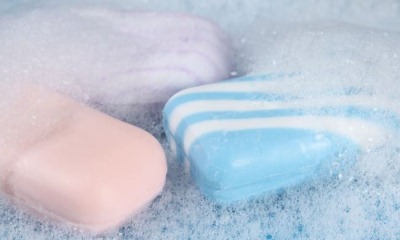 Warm water is poured into a basin or any other container. The volume should be large enough, as the woolen stole absorbs a lot of water... The optimum temperature for washing powder puffs is 30-40 degrees.
Warm water is poured into a basin or any other container. The volume should be large enough, as the woolen stole absorbs a lot of water... The optimum temperature for washing powder puffs is 30-40 degrees.
Add one of the suitable detergents to the container. The handkerchief is soaked in soapy water for about 10-15 minutes. After that, the product is washed with soft squeezing movements.
After washing, the shawl is rinsed until the soap foam has completely disappeared. At the last rinse, add a conditioner for woolen garments to the water..
It can be replaced with a little vinegar (no color scheme), lemon juice, or a conditioner hair rinse. Squeeze the cobweb very carefully, squeezing and unclenching the lump.
When washing by hand, you must not:
- stretch the scarf by the ends;
- pour detergent onto the shawl;
- rinse the cobweb under the tap;
- rub the canvas, holding it in your hands;
- wipe off dirt with a brush;
- twist in the usual way.
It is not advisable to make the water colder, as it will not cope with pollution. High temperatures can damage the fluff.
In the washing machine
 To wash heavily soiled knitted shawls with a washing machine, you must select a mode for woolen items or a delicate wash at a temperature of 30 degrees.
To wash heavily soiled knitted shawls with a washing machine, you must select a mode for woolen items or a delicate wash at a temperature of 30 degrees.
The whole process should include only two stages - directly washing and rinsing. The spin stage should be switched off. Automatic drying is also not needed.
The shawl must not be machine washed at the same time as other items. It is pre-placed in a special mesh bag of a suitable size..
The detergent is selected from the list of approved down products. However, it must be suitable for use in an automatic machine.
After the end of the cycle of work, the stole is left for some time in the drum to completely drain the water.
How to whiten white?
Washing solves many problems with cleanliness and color, but it is not able to return the original color to the snow-white cobweb. A tarnished shawl must be bleached.
You can choose any of the recipes:
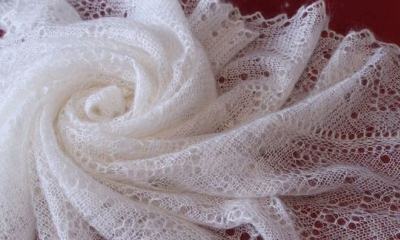 The first recipe consists of 10 liters of warm water and 2 tablespoons of hydrosulfite powder. In such a solution, the scarf is kept for 30 minutes, periodically turning it over.
The first recipe consists of 10 liters of warm water and 2 tablespoons of hydrosulfite powder. In such a solution, the scarf is kept for 30 minutes, periodically turning it over.- The second recipe is calculated by the weight of the shawl. For 100 g of the product, take 10 liters of warm water, 5 tablets of hydroperite and 10 teaspoons of ammonia. The soaking time is 12 hours.
- According to the third recipe, you need to take 1 tablespoon of hydrogen peroxide per 100 grams of the product. A six-hour soak is also carried out in warm water.
- The fourth recipe is to use 5 hydroperite tablets and 1 tablespoon of hydrogen peroxide. This amount is calculated for 7 liters of water. The exposure time is 30 minutes.
- The fifth recipe prescribes the use of baking soda (baking soda or soda ash). The powder is dissolved in water and the shawl is soaked for 2 hours.
So that the water does not cool down during long-term bleaching, the basin is placed on a warm heating pad.
It is allowed to use liquids based on hydrogen peroxide... It is not recommended to bleach the cobweb too often, since any reagent will thin the thin downy thread.
How to dry?
The drying step is just as important as the washing itself. This penultimate stage of work should take place in a room free of foreign odors. The drying down shawl should not be exposed to direct sunlight and heat from batteries.
Since the shawl can not be twisted either by hand or in a centrifuge, you have to use more gentle methods. They allow you to keep the volume, shape, knitting of the scarf.
Naturally
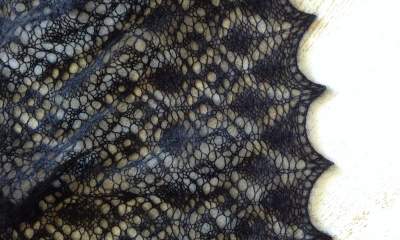 After manual or automated washing, the stole is placed in a mesh or gauze container and hung over the bathtub.
After manual or automated washing, the stole is placed in a mesh or gauze container and hung over the bathtub.
After the excess water drains, the openwork thing is laid out on a fabric that absorbs moisture well.... It can be a terry towel or a cotton sheet folded in several layers.
In this state, the shawl dries naturally. Shake it periodically, and change the cotton base to dry. You cannot hang a knitted scarf on a rope, as after that it will lose its shape.
On a towel
A wet downy shawl is spread on a terry towel of a suitable size. Then both products are rolled together.
After the bundle is wet, the raw terry base is replaced with a new one... This procedure is done two to three times.
On a frame or hoop
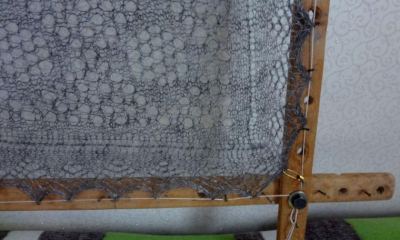 Stores sell a special frame (or hoop) for drying downy shawls. To use it, nylon fishing line or thick thread is threaded along the edge of the shawl.
Stores sell a special frame (or hoop) for drying downy shawls. To use it, nylon fishing line or thick thread is threaded along the edge of the shawl.
Then, with the help of pushpins or small nails, the product is fixed on the frame. After one to two hours, the buttons and fishing line are removed, and the shawl is left to dry naturally.
The frame is easy to make by hand... To do this, a shape is made from wooden slats that repeats the perimeter of a square scarf, triangular scarf or rectangular stole. The sides of the frame should slightly exceed the length and width of the shawl.
How to fluff after drying?
To return the pomp and volume to the woolen shawl, it must be fluffed up. This is done after rinsing and lightly wringing.
After freezing, the scarf is allowed to melt completely and then it is dried using a frame... Next, the fluff is gently lifted with a comb or massage comb with blunt teeth. This is done only after the canvas is completely dry; you cannot comb a wet shawl.
Another way to fluff is hanging a dry shawl in the wind. It is also necessary to take into account the fact that when worn, the scarf will naturally become more magnificent. That is why knitters recommend wearing a knitted puff as often as possible.
Related Videos
The video will tell you how to wash and dry a downy shawl:
Conclusion
So that the downy shawl retains its original beauty and does not lose its warming properties, it is important to follow a consistent cleansing technology... It includes pre-cleaning, direct washing, drying and fluffing.
For snow-white shawls, delicate bleaching is also relevant. Subject to all the rules, the shawl retains all its qualities and aesthetic appearance.

